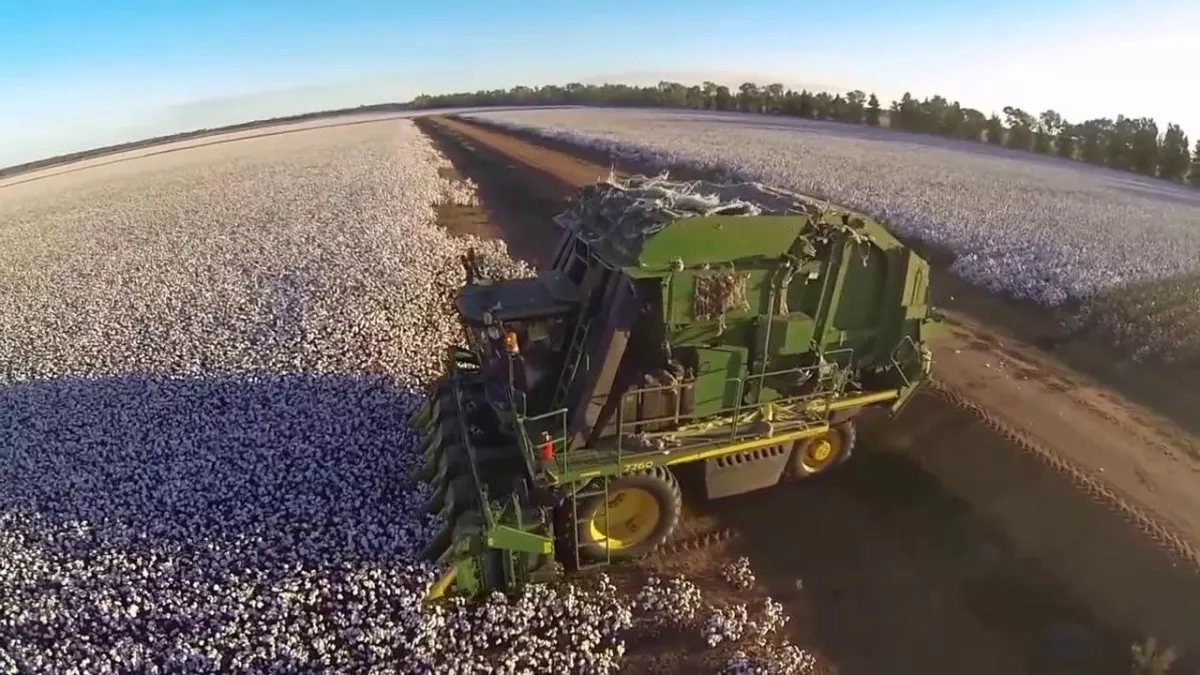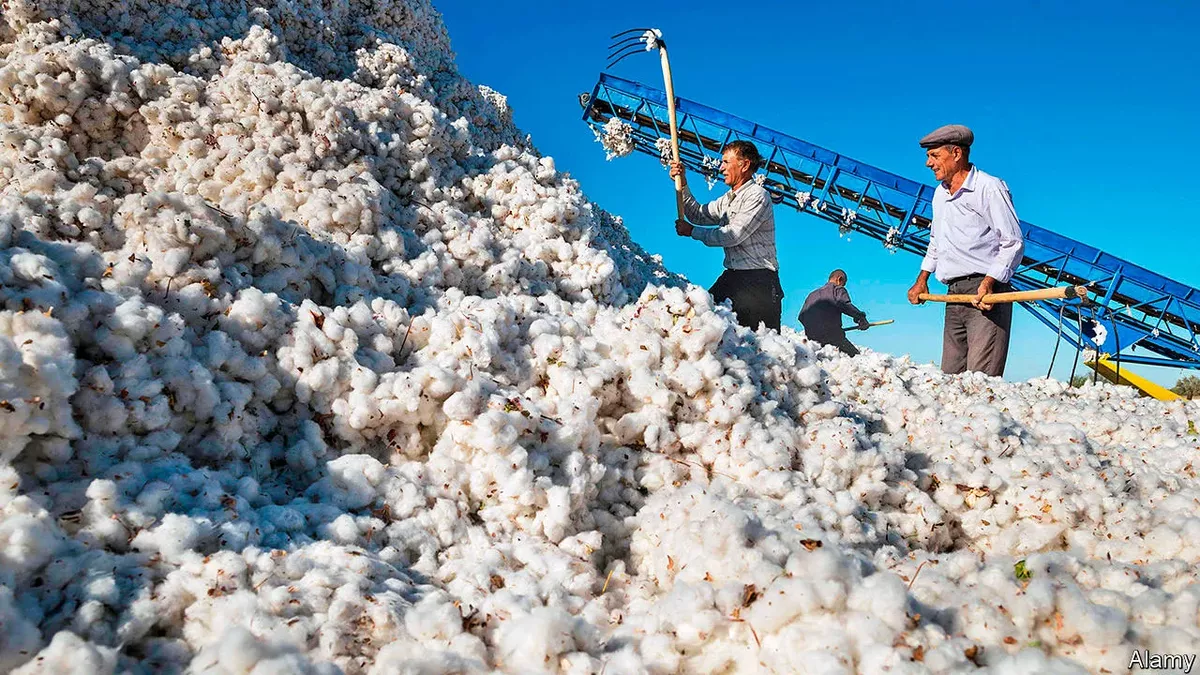Azerbaijan’s white gold: from farm to fabric Challenges and prospects in cotton production
At the end of last year, leading cotton-producing countries experienced a decline in output due to falling prices, driven by lower oil prices and high projected stockpiles of raw cotton. Over the first seven months of 2025, the market situation worsened amid a production boom in the U.S., India, and Brazil. According to Trading Economics, cotton futures fell below $0.60 per pound in July, matching the 2020 record low.
Azerbaijan experienced similar trends, with cotton production dropping by 13.5% last year. Production and export revenues continue to face pressure in 2025. Yet between January and August, cotton fibre output increased by one-third, highlighting a new trend: Azerbaijan is shifting toward greater processing of raw cotton and the production of finished goods.
The 2022–2023 period was highly challenging for the global cotton industry. Extreme droughts caused cotton yields to fall by 28–30% in major producers including India, China, the U.S., and Brazil. Pakistan also faced severe setbacks, with torrential rains destroying nearly 20% of its crop. Declines were reported in Australia and Benin as well. Together, these countries account for more than three-quarters of global cotton production, highlighting the scale of the impact.
The situation improved only slightly last year. According to December data from the International Cotton Advisory Committee (ICAC), cotton prices continued to trend downward, driven by higher production and stock forecasts, as well as low crude oil prices, which reduced the cost of synthetic fibres.
This forecast largely materialised. In the U.S., cotton production for the 2024–2025 season rose by 5.9%, while favourable weather in India allowed cotton-planted areas to expand by 8%. In the first half of the year, Brazil exported a record 12.4 million bales, surpassing the U.S. for the first time. Meanwhile, China, the world’s largest cotton importer, significantly reduced its purchases on international markets.
Overall, the global cotton stock-to-use ratio now exceeds 68%—a worrying indicator of oversupply and declining demand. Consequently, by July 2025, cotton prices fell to their lowest level in five years. Trading Economics reports that futures dropped below $0.60 per pound of raw cotton, matching the mid-year record low seen in 2020.
Notably, weak global demand and falling raw cotton prices are far from the only challenges facing the industry. According to recent studies by the Food and Agriculture Organization of the United Nations (FAO), climate-related issues, acute shortages of irrigation water, and rising costs of fuel, fertilisers, and pesticides have significantly undermined the sector’s profitability. These pressures have forced farmers in poorer countries to abandon unprofitable cotton production in favour of more competitive crops. Cotton growers in Central Asia face similar challenges, and unfortunately, Azerbaijan is no exception.

In recent years, Azerbaijani cotton farmers have struggled with adverse climate conditions and a shortage of fresh water for irrigation, particularly during the summer. In 2023, water supply problems affected farms in the Aran region and other lowland areas, while the number of extremely hot days (above 40°C) far exceeded the climatic norm. Cotton cultivation—requiring frequent and generous watering during the spring vegetative growth period—suffered the most. In the summer of 2025, farmers in the Sabirabad district were forced to irrigate cotton fields with brackish water from the “Ana Canal” due to the shortage of fresh water.
The situation with irrigating cotton fields in Azerbaijan’s southern and central regions remains challenging. Nevertheless, with support from the Ministry of Agriculture and the state leasing agency, several agro-parks and large farms have implemented efficient irrigation systems and modern harvesting combines. High-yielding cotton varieties from the U.S., Türkiye, and Greece are being used alongside advanced agronomic practices. These measures have raised yields on leading farms to 50–60 centners per hectare. However, the national average yield still hovers around 28–30 centners per hectare—roughly half that of the world’s industry leaders.
Rising farm expenses make regular wage and tariff indexation necessary. In 2021–2022, cotton purchase tariffs were increased several times, reaching 800 manats ($470) per ton for first-grade cotton. Farmers also receive a subsidy of 170 manats per ($100) ton delivered to collection points. In early September 2025, the Agricultural Subsidy Council approved an increase in cotton subsidies for the 2026 agricultural year to 215 manats ($126) per ton for cotton grown on fields equipped with modern irrigation systems.
The measures outlined above have undoubtedly helped improve productivity in cotton fields, but the results remain modest. According to the State Program for the Development of Cotton Production in Azerbaijan for 2017–2022, approved in 2017, raw cotton production was expected to reach 500,000 tonnes per year. Unfortunately, this target was not achieved: according to the State Statistics Committee, Azerbaijan harvested 276,100 tonnes of raw cotton in 2023, a decline of 14.4% compared to the previous year.
In 2024, cotton was sown on approximately 100,000 hectares, but heavy rains during the harvesting period—late summer and early autumn—significantly reduced yields. Final figures for the current year have not yet been released; however, data from the State Statistics Committee for January–May 2025 show more than 44,316 tonnes of raw cotton produced, a 29.9% increase compared to the same period last year. It should be noted that cotton harvesting occurs from August to October, so these figures do not yet fully reflect the current state of the industry.

Regarding exports, according to the State Customs Committee (SCC), between January and July 2025, Azerbaijan shipped just under 76,300 tonnes of raw cotton to international markets, valued at $109.736 million, a decline of 13.2% compared to the same period last year.
Nevertheless, despite challenges in raw cotton production, the country is showing strong growth in cotton processing. According to the latest SCC data, between January and August 2025, Azerbaijan produced 47,910 tonnes of cotton fibre, an increase of 32.6% compared to the same period last year. This fibre is increasingly in demand on the domestic market.
Moreover, in the first half of 2025, Azerbaijan imported 607 tonnes of cotton yarn worth $1.3 million, up 40% in value and 44% in volume compared to last year. This data indirectly reflects a gradual restructuring of the sector: the country is implementing plans to process raw cotton as fully as possible, produce yarn and fabrics, and eventually manufacture clothing. In other words, the focus is shifting toward higher value-added products, which over time are expected to replace raw cotton as the main export commodity.
In recent years, textile enterprises have been established in Sumgayit, Mingachevir, and other cities, while textile and garment factories operate in Baku and the Saatli district. Garment production facilities have also been set up in Ganja, Yevlakh, Lankaran, Bilasuvar, Lachin, and Khankendi. Azerbaijan has conducted intensive negotiations in recent years with business circles in Türkiye, Pakistan, China, and Uzbekistan to attract investment into the spinning, textile, and garment industries, including in agro-industrial clusters being developed in the Karabakh region and in the Alat free industrial zone.
The most successful progress has been on the Azerbaijan-Uzbekistan business track. In July 2024, Azerbaijani company TST Textile Group and Uzbek company Tukımachı Sanoat Tekstıl signed a contract to cultivate cotton and produce cottonseed oil at the Imishli agro-park. Overall, between 2025 and 2029, the Uzbek investor plans to invest 92.5 million manats ($54.4 million) in building facilities for yarn, textile, and garment production, which will be located in the Mingachevir Industrial Park. Additionally, in Khankendi, a large garment factory built by Uzbek investors is already operating, employing over 200 people.








